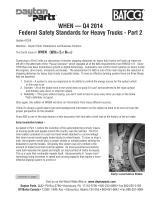

WHEN — Q4 2014
Dayton Parts LLC
continued on page 3
(continued from page 1)
2
George Westinghouse
Early Locomotive Brake Diagram
Charging
At rest the Westinghouse brake system has no air in it.
As the air compressor on the locomotive pumped air into
the brake pipe, the system is charged and the brakes are
released. The triple valve directs air into the reservoir on
each carriage where it’s held for use in applying the
(service)
brakes when needed.
Applying
When the engineer wants to apply the brakes he moves
the brake handle to the proper location and air is removed
from the brake pipe. When the triple valve senses this
pressure drop in the brake pipe it allows air from the
reservoir into the brake cylinder and the brakes are
applied.
Releasing
To release the brakes, the engineer again moves the brake handle to the proper location which refills the brake pipe
with air. The triple valve senses this increase in brake pipe pressure and releases the brake cylinder by venting the air
into the atmosphere. Then the whole process starts over again by recharging the air reservoir.
The original air brake –
In 1869 at the age of 22, George Westinghouse designed an air brake system which addressed the issues facing the
rail industry at that time. First he solved the problem of air supply by mounting an independent air reservoir on each
carriage. The heart of his system was the triple valve he invented which attached directly to the brake pipe and
controlled air to the reservoir and the brake cylinder. It was called a triple valve because it served three functions —
charging, applying, releasing.
The next generation of locomotive brakes added an air compressor
(imagine
that !)
to the engine so pressurized air could be used to push a lever
(force
multiplier)
that applied brake blocks to the wheels of the locomotive
(at the
front of the train)
. This compressor also supplied a brake pipe that ran the
length of the train, connected between carriages with gladhands. This brake
pipe connected to an air cylinder on each carriage, which pulled on the
handbrake chain whenever it was pressurized, applying the brakes. This
system worked ok for the front cars but it took a long time to pump air all the
way down the train. Also if one of the gladhands happened to disconnect or
a bad leak occurred anywhere, the entire brake system would fail. Not a very
reliable design.
At this early stage of air brake development, when the brakes were applied
the average freight train, traveling at 45-50 mph, would take 800 to 1200
yards to come to a complete stop. In other words a train needed a minimum
of 2,400 feet or essentially a half a mile of clear rail in front of it to stop
safely. A pretty tall order considering life is full of things
“that happen”
. A
reliable, more effective brake system was needed with the ability to be
applied and released quickly down the entire length of the train.
Enter a young inventor and entrepreneur named George Westinghouse.

















